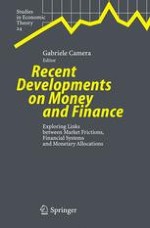2006 | Buch
Recent Developments on Money and Finance
Exploring Links between Market Frictions, Financial Systems and Monetary Allocations
herausgegeben von: Charalambos D. Aliprantis, Nicholas C. Yannelis, Professor Gabriele Camera
Verlag: Springer Berlin Heidelberg
Buchreihe : Studies in Economic Theory
